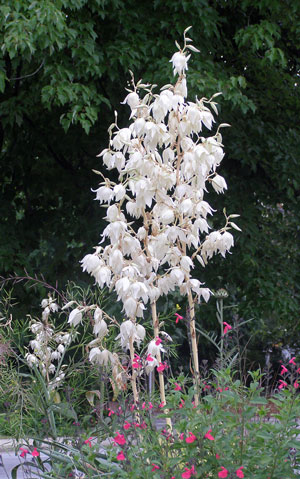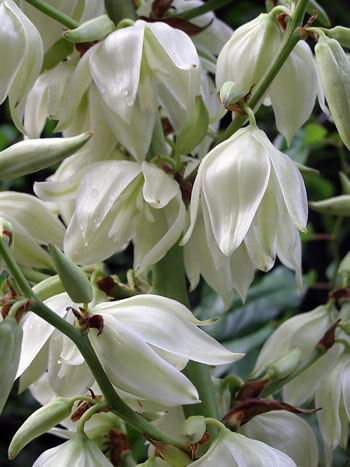
By Ken Moore
Flora Columnist
Now that yuccas are very noticeable as they approach full flowering, I remember a camping trip of a few years ago. It was early spring out in the Southwest, and our campsite was nestled down in desert vegetation, including many of the locally common yucca. The site is memorable; those yuccas were blooming, and the ground was literally carpeted with fallen flowers.
We quickly learned to carefully navigate in and around the campsite to avoid direct contact with the needle-pointed, spear-like foliage. A run-in with a leaf or two makes one appreciate the common name, Spanish bayonet.
I was in charge of hustling up the breakfast, and remembering that yucca flowers, as well as the buds and fruit, are edible, I thought I’d experiment. Having most of the desirable ingredients of primitive camping –olive oil, onions, garlic, peppers and eggs – I thought I’d add some fresh yucca flowers, just to see how edible they might be. Not surprisingly, my camping mates were skeptical, but willing to trust me. The resulting omelet-like concoction was delicious (like anything that includes onions sautéed in olive oil). So, for our several days there, we enjoyed yucca flower omelets as well as yucca flower-enhanced pasta sauces.
I’ve enjoyed watching a single yucca, Yucca filamentosa, just beyond my front porch, send up its giant asparagus-like stem of tightly clustered flower buds. Now the impressive flowering branch, a panicle, sporting buds and flowers, stands 7 feet tall above the basal rosette spear-like leaves.
My single plant is not nearly as spectacular as those so obvious now above the retaining walls along the bypass around Carrboro. Those most likely are volunteers, having found their way there thanks to traveling animals that have eaten the fruit.
More deliberate and quite engaging is the colorful ornamental Chapel Hill Tire landscape opposite the PTA Thrift Shop in Carrboro. Designed by Ginay Gregory of Beyond the Pail landscape design and consulting, that always-something-of-interest-to-see busy corner of our town now sports dramatic flowering stems of yucca – in this case, a variegated leaved cultivar.
Yuccas, like the onions and garlic in my camping concoction, are in the lily family, or at least they were until recently. Taxonomists are still working on new classifications within the former lily family. Meanwhile, take a closer look at a single yucca flower. It’s a perfect lily, characterized by three sepals (the outer set) and three petals (the inner set) appearing alike, thus called tepals. Inside the tepals you’ll spot six stamens surrounding a smallish, egg-shaped, superior ovary – superior because it’s situated above the stamens and tepals. Those are some of the basic characteristics of the lily family, with which you may impress friends and neighbors.

By the way, just this past Memorial Day morning, I took advantage of my very own yucca flowers and, if I do say so myself, concocted a most delicious egg dish, including, of course, onions, garlic and olive oil.
Dr. Jim Duke’s Handbook of Edible Weeds describes other edible qualities of yucca. He also elaborates on the rich Native-American medicinal heritage of yucca root, including a root poultice used to prevent baldness. Well, I’m way too late to try that remedy!
Email Ken Moore at flora@carrborocitizen.com.
Find previous Ken Moore Citizen columns at The Annotated Flora.

